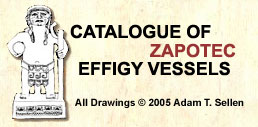| Key: EMB 28354 |
| Actual Location: Ethnographic Museum (Ethnologisches Museum), Berlin, Germany. |
| Collection: Edward Seler 1897 |
| Registration: IV Ca. 28354 |
| Provenance: Yatzechi, Oaxaca. |
| Measurements: 21.9 x 12 dia. cm. |
| Color: Grey clay with traces of a lighter grey paint. |
| Chronology: MA V (Eubanks 1999: 148); Late Xoo 600 - 800 AD |
| Click to view Chronology |
| Reference: Fuhrmann 1922: plate 65; Boos 1968: 2; Schuler-Schömig 1970: 87, plate 117; Mongne 1987: 39 (drawing); Eubanks 1999: 147-148, fig. 119; Deimal and Ruhnau 2000: 18; Sellen 2002: 14, fig. 12a (drawing). |
| Comments: Mongne (1987: 39) published this piece as an example of forgery, but thanks to the TL test (Goedicke et al, 1992), we know it is authentic. There is a very similar piece at the British Museum of London (see BM1964/AM 19/6). The ear of corn is a representation of the virile member pierced by a cord in an act of ritual bleeding (cf. Sellen 2002: 14). Also see MFVW 274 for another human figure holding a blood letting cord in his hand. |
| Glyphs: Glyph C in the headdress. The broken part of glyph C has been repaired. |
| Dating: TL by Goedicke et al. 1992: 71, test 117, authentic (TL's date: 1144-1272 AD). |
|
